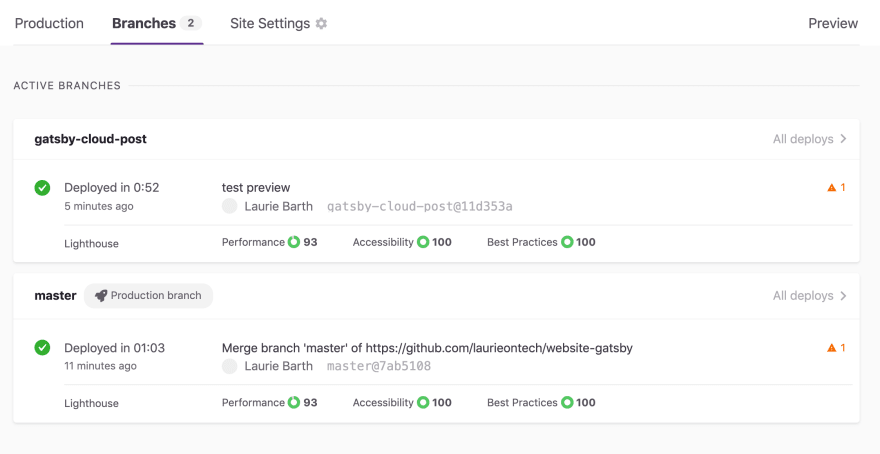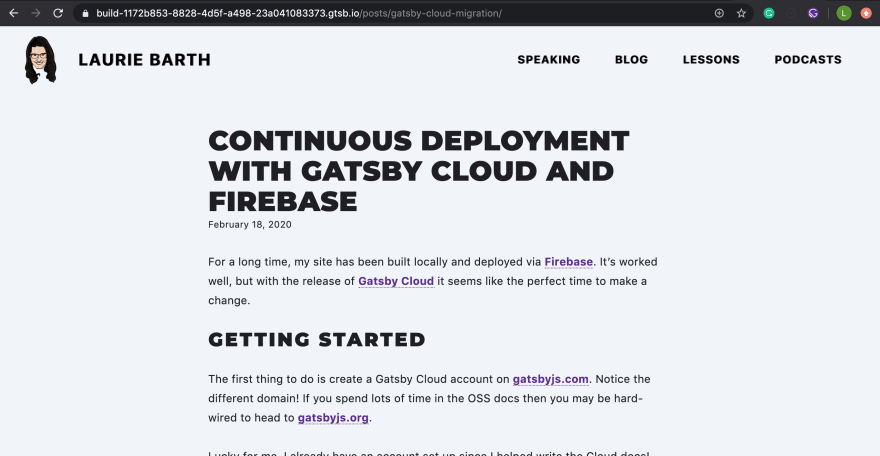Originally posted on laurieontech.com
For a long time, my site has been built locally and deployed via Firebase. It's worked well, but with the release of Gatsby Cloud it seems like the perfect time to make a change.
Getting Started
The first thing to do is create a Gatsby Cloud account on gatsbyjs.com. Notice the different domain! If you spend lots of time in the OSS docs then you may be hard-wired to head to gatsbyjs.org.
Lucky for me, I already have an account set up since I helped write the Cloud docs!
Creating a new site
I'll start with "Create a new site". Since I already have a Gatsby site I want to connect to I'll choose that option and select my GitHub repo.
Note that you can auto-provision a site using Gatsby Cloud. This is a pretty cool way to set up a barebones project with a specific CMS.
The GUI gives me the option to specify a directory path to build and/or a branch. Since I plan to deploy the master branch root project I don't have to do anything here.
Next!
My site is also based on static content stored directly in my project. So no CMS to set up. More configuration steps I can skip!
Building my site
This section is actually kind of unnecessary. I don't need to do anything! Now that my repo is configured to use Gatsby Cloud, it's already building.
Though the logs may or may not be shaming me for my outdated dependencies...oops. I really keep meaning to fix that. But on the bright side, none of them have vulnerabilities!
Ok, site is built. Took ~4 minutes and should be even faster next time around. Sweet 😊
As it turns out I had reason to build again before I published this post. Builds take less than a minute now!
Preview
From the Cloud dashboard, I can click the "Branches" tab and look at all the current branches for my project. This means I can preview this blog post before it's live!
If I head to "All deploys" for the gatsby-cloud-post branch I can launch the most recent build of that branch. And there it is, my in-progress blog post!
My site is small enough that it likely makes just as much sense to run gatsby develop locally. But having this option is nice since I always run a gatsby build and then gatsby serve to make sure I haven't broken anything.
Setting up Hosting
Ok, now that I have a site set up I can head to "Site Settings" to configure my hosting integration.
It's down in the integrations section of the side nav all the way at the bottom of that page.
I could definitely use this opportunity to switch over to Netlify, and I may in the future. But for now, I know my domain is set up for Firebase and that's all working. So I'll start there.
If I select Firebase and authenticate with the site it prompts me to pick what project I want to deploy. Again, this is already set up and I've been using it for a while. So "laurieontech-site" it is.
And...I'm done? Ok, I'm actually super impressed, and I work here!
Just to double-check I went to the firebase console. As expected it shows a brand new deployment timestamp. 🥳
What next?
Now I can update my site and every time I commit it will trigger a rebuild. If I commit to master it will also redeploy. This is awesome!
Guess this means I need to stop committing directly to master. 😅 Otherwise, I'm going to end up with a lot of published in-progress blog posts!









Top comments (10)
Thanks for your time in writing this article.
I'm using Gatbsy for a blog already, mostly for the SEO score and the speed.
Regarding the deployment, since Gatsby produces flat, lifeless HTML files for low budget blogs and simple landing pages, it might be a good solution to use a simple local build with and an FTP upload using
ftp-deployNode.js module.Gatsby can be used that way, but a majority of Gatsby sites are applications making use of React and hydration! You can check out the docs for more info.
In this case, the remote/cloud build enhances in some way the final product?
Basically the build, local or remote is the same thing.
Heroku has a similar build workflow (and maybe other platforms) triggered from the REPO commits, super useful for Python apps that require a basic setup (modules compilation, provisioning).
Anyway, Gatsby is something that I plan to use for a long time, for sure.
One last question, at the end: any plan to open a commercial marketplace to encourage companies to develop more themes and UI Kits?
Thanks for your time!
The remote build can be triggered by CMS content updates and it's more performant. So there are great benefits depending on what your use case is.
In terms of commercial marketplace I honestly don't know. But it's a fun idea!
Keep up the good work!
See u
Cool post 👍.
Is there an advantage to do that instead of the GitHub-netlify way? 🤔
Gatsby cloud is specifically designed to build Gatsby sites at the fastest speeds possible. Adding in Lighthouse audits and preview functionality made it a better choice for me.
I also got to continue using firebase and didn’t have to reset up my DNS.
Ok, I'll try it then.
Thanks !
Excellent article! I love how Gatsby Cloud makes it so simple to recommend Gatsby to folks who might have had trouble setting up their own devops to get builds running and a preview server.
Wow, this is incredible. I love the progress Gatsby is making. Great article Laurie!